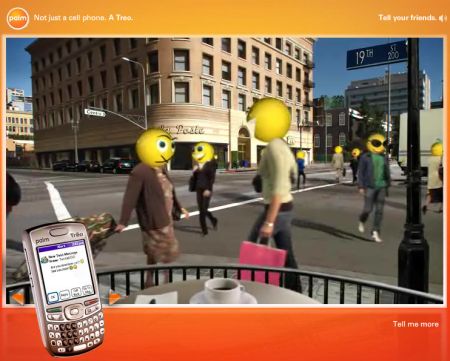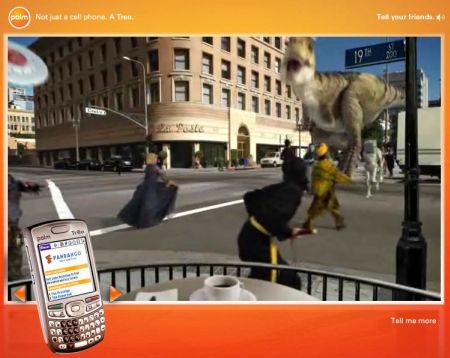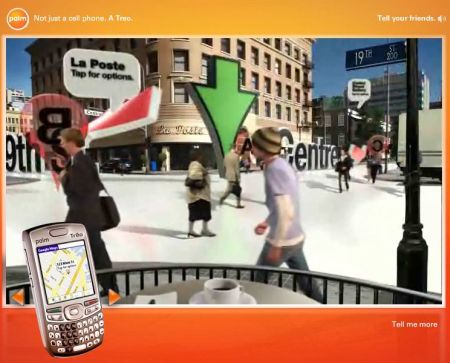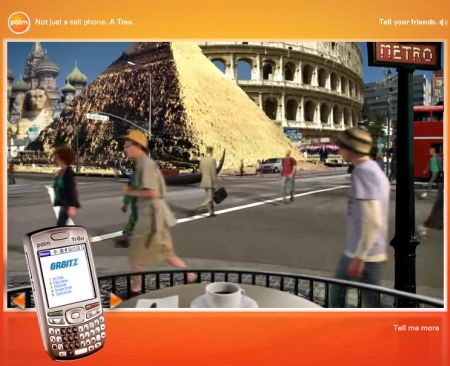von Roland Hachmann | Dez. 17, 2006 | Ad News, Blog, Digital Marketing, Online Advertising
I just found a funny microsite by accidentally (!) clicking on a banner. It did, however, entertain me for a few minutes, trying to explore what’s possible on that site.
The site shows a typical street crossing with people walking around in all directions.
Then, clicking on the treo options (the orange arrows), the scenery changes slightly. When selecting the Yahoo! chat option, for example, the people walking around suddenly have a yellow smiley icon instead of their head.

In this example, I selected fandango, a site for movie and theatre tickets:

Or, choosing Google Maps:

And here I chose Orbitz, a travel site:

Nice idea to demonstrate the everyday capabilities of the Treo.
von Roland Hachmann | Dez. 12, 2006 | Blog, Digital Marketing, Marketing Trends, Online Advertising
Engagement By Engagement points me to Ten Mega Trends Transforming Marketing Measurements
They sound reasonable:
- Digital Network Adoption
- Attention Erosion
- Speed of Measurement
- Democratization of data and analytics
- Observational Measurements
- Unstructured Data
- Beyond Demographics
- Customer centric measurements and planning
- Data integration comes of age
- Reevaluating relationships with whom and what we measure
More detail on the linked website, well worth a read.
(Well, apparently, it was originally posted here by the author)
von Roland Hachmann | Dez. 6, 2006 | Ad News, Blog, Digital Marketing, Digital News, Online Advertising
Marketers Websites attract more eyeballs than other media, according to AdAge:
Believe it or not, those boring corporate websites are pulling in more eyeballs — and more influencers — than the flashy prime time TV shows, print magazines and general interest sites on which marketers advertise.
In figures, to be precise:
Yet the websites of P&G and Unilever now reach nearly 6 million and 3 million unique visitors, respectively, in the U.S. each month, according to ComScore Media Metrix.
But it’s not only about more eyeballs, these eyeballs are also quite interesting for marketers, as they are usually influencers, or at least people who actively engage with the brand in considerable numbers.
Their engagement with corporate and brand sites is well above the norm for the general population. „Visitors to [corporate and brand] websites have a much higher propensity to recommend products,“ said Pete Blackshaw, chief marketing officer of Nielsen Buzzmetrics, whose research shows more than 40% of people who give a brand e-mail feedback are likely to recommend it to others.
Much of it is derived from „regular“ online Advertising:
Much of the traffic to the big package-goods marketers‘ sites appears to be coming the way originally envisioned in the online advertising model: as a response to online display advertising. Search-heavy Google accounts for a relatively small amount of traffic to the P&G and Unilever sites compared with display-ad-heavy Yahoo
That doesn’t surprise me at all, since most of P&Gs and Unilevers products are FMCG, for which I assume users usually don’t search much. Or if people do search for these kind of things, then the FMCG companies haven’t found the right way to effectively keyword advertise.
von Roland Hachmann | Dez. 4, 2006 | Blog, Digital Marketing, Digital News, Online Advertising, Social Media Marketing
Micro Persuasion points me to a piece of research about the fact that:
The online world is just as important as the real world, feel a large portion of internet users in the United States. […] 43 per cent of internet users who are members of online communities „feel as strongly“ about their virtual community as their real world community.
I wonder if those figures are similar in Germany or Europe in general. What also means, especially for us marketers: build a strong community around your brand (in any way possible: blogs, forums, etc.) and you should – in theory – reach a certain level of relevance and „feel strongly“-factor for your brand.
von Roland Hachmann | Nov. 27, 2006 | Blog, Online Advertising
A nice online ad idea can be found at the Sloganmaker Blog:
Hit the pedal and enjoy. Wonder how they did it?
von Roland Hachmann | Nov. 26, 2006 | Blog, Digital Culture, Digital News, Online Advertising
I haven’t done this in a while, since I prefer proper Blogposts to link lists, but here is a bullet point list of articles about „web 3.0“:
- Robert Scoble writes about Bill Gates and the fact that Bill Gates thinks we’re again in some sort of bubble. Also providing his own view why he thinks that this is not necessarily true.
- Dan Farber from ZDNet also thinks that Web 3.0 is bubbling up. And it will be the Semantic Web.
- The NY Times Article announces Web 3.0 and is seemingly widely discussed. If anything, there is one interesting point:
In its current state, the Web is often described as being in the Lego phase, with all of its different parts capable of connecting to one another. Those who envision the next phase, Web 3.0, see it as an era when machines will start to do seemingly intelligent things.
- Ross Mayfield says there is no „Web 3.0“ and calls it a Marketing Desaster.
It is about the semantic web, which is fine, generally speaking. But I just think there is too much future-hype in this. Web 2.0 hasn’t even happened for the average Joe-on-the-Web. It’s entertainning to think about how „Web 3.0“ will look like, but let’s still focus on Web 2.0 for now, ok?






 Wo ich sonst so bin...
Wo ich sonst so bin...